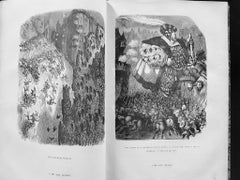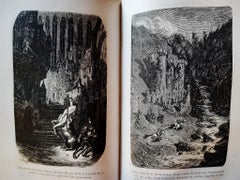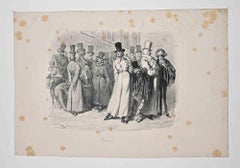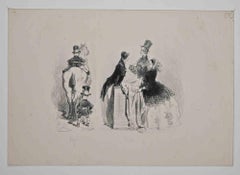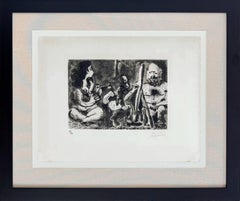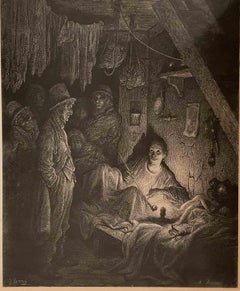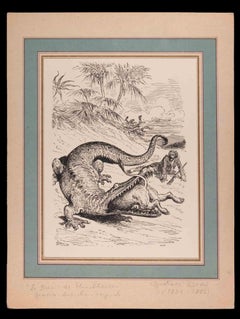Gustave Doré Art
to
1
5
Overall Width
to
Overall Height
to
5
4
3
2
2
2
2
1
3
1
1
1
27
8,780
2,809
1,654
1,312
4
1
Artist: Gustave Doré
Gargantua - Rare Book Illustrated by Gustave Dorè - 1854
By Gustave Doré
Located in Roma, IT
Gargantua is an original modern rare book by François Rabelais illustrated for the first time by Gustave Doré (Strasbourg, 1832 – 23 January 1883) in 1854...
Category
1850s Modern Gustave Doré Art
Materials
Woodcut
Les Contes Drolatiques - Rare Book Illustrated by G. Doré - 1861
By Gustave Doré
Located in Roma, IT
Les Contes Drolatiques is an original modern rare book written by Honoré de Balzac (1799 – 1850) and illustrated by Gustave Doré (Strasbourg, 1832 – 23 January 1883) in 1861.
Publis...
Category
1860s Modern Gustave Doré Art
Materials
Paper, Etching
CHASSEURS TYROLIENS A L'AFFUT DU CHEVREUIL
By Gustave Doré
Located in Santa Monica, CA
GUSTAVE DORE (French 1832-1883)
CHASSEURS TYROLIENS A L'AFFUT DU CHEVREUIL (Tyrolian Hunters at the end of the Hunt) c. 1856-7 (Beraldi?)
Lithograph,...
Category
1850s Romantic Gustave Doré Art
Materials
Lithograph
$600 Sale Price
45% Off
Parisian - Lithograph by Gustave Dorè - 1854
By Gustave Doré
Located in Roma, IT
Parisian is aLithograph realized by Gustave Dore in 1854.
Good conditions except for some foxings.
Hand-singed.
The artwork is depicted in a well-balan...
Category
1850s Modern Gustave Doré Art
Materials
Lithograph
Ménagerie Parisienne - Lithograph by Gustave Dorè - 1854
By Gustave Doré
Located in Roma, IT
Ménagerie Parisienne is an Original Lithograph realized by Gustave Doré (1832-1883).
Very good condition included a white cardboard passpartout (50x62.5 ...
Category
1850s Modern Gustave Doré Art
Materials
Lithograph
Related Items
Les bleus de Barcelone
By Pablo Picasso
Located in OPOLE, PL
This work will be exhibited at Art on Paper NYC, September 4–7, 2025.
–-
Technique: Aquatint and etching
Paper: Gourbeyre wove paper with watermark “Au Vent d’Arles”
Edition: 73/75...
Category
20th Century Modern Gustave Doré Art
Materials
Etching
Cypriano (A Basque Boy)
By Gerald Leslie Brockhurst
Located in Middletown, NY
Etching on cream wove paper. 6 5/16 x 3 3/4 inches (159 x 94 mm), full margin. Signed in pencil lower center margin, from the edition of 111. A well inked impression with a minor cre...
Category
Mid-20th Century American Modern Gustave Doré Art
Materials
Handmade Paper, Etching
Starry Night - Limited Edition, Figurative, Contemporary, Star, Night, Child
By Charlie Mackesy
Located in Knowle Lane, Cranleigh
Starry Night is a lithograph based on a watercolour by Charlie Mackesy. The edition is limited to 150 and each piece has been signed by Charlie Mackesy...
Category
2010s Other Art Style Gustave Doré Art
Materials
Lithograph
$3,437
H 11.82 in W 7.88 in D 0.4 in
Mick Jagger V - Andy Warhol, Announcement card, Rolling Stones, Musician, Pop
By (after) Andy Warhol
Located in Knowle Lane, Cranleigh
Mick Jagger V - After Andy Warhol. The light green background contrasts with the abstract pink slashes on the image of this lithographic print. Mick Jagger is an iconic rock legend who was the frontman and one of the founders who sang lead in the British Rock and Roll Band, The Rolling Stones...
Category
1970s Pop Art Gustave Doré Art
Materials
Lithograph
$1,306
H 12.01 in W 8.67 in D 0.79 in
Ulysses Deriding Polyphemus: A Framed 19th C. Engraving After J. M. W. Turner
By J.M.W. Turner
Located in Alamo, CA
This beautiful 19th century framed hand-colored engraving/etching entitled "Ullyses Deriding Polyphemus" by Edward Goodall is based on an original 1829 painting by the renowned Briti...
Category
Mid-19th Century Romantic Gustave Doré Art
Materials
Engraving, Etching
$675
H 13.88 in W 17.25 in D 1.5 in
Hand of Africa - Mandela, Former South African President, Signed Artwork, Hand
By Nelson Mandela
Located in Knowle Lane, Cranleigh
Nelson Mandela, Hand of Africa, Signed Limited Edition Lithograph
Many people are unaware that Nelson Mandela turned his hand to art in his 80's as a way of leaving a legacy for his ...
Category
Early 2000s Contemporary Gustave Doré Art
Materials
Lithograph
$20,627
H 25.5 in W 20 in D 2 in
Mick Jagger X - Andy Warhol, Announcement card, Rolling Stones, Musician, Pop
By (after) Andy Warhol
Located in Knowle Lane, Cranleigh
Mick Jagger X - After Andy Warhol. This black and white colour scheme lithographic print features - Mick Jagger - an iconic rock legend who was the frontman and one of the founders ...
Category
1970s Pop Art Gustave Doré Art
Materials
Lithograph
$1,306
H 12.01 in W 8.67 in D 0.79 in
Original Vetements Forchic French fashion vintage poster
Located in Spokane, WA
Original lithograph, linen backed. Vetements Forchic. Pour Lui; Elle a Choise. Archival linen-backed vintage French fashion poster in fine...
Category
1940s American Modern Gustave Doré Art
Materials
Lithograph
$1,000 Sale Price
20% Off
H 61 in W 44.25 in D 0.05 in
A View of Dover, England: A Framed 19th C. Engraving After J. M. W. Turner
By J.M.W. Turner
Located in Alamo, CA
This beautiful 19th century framed engraving "Dover" by Thomas Lupton is based on an original painting by the renowned British artist J.M.W. Turner, which depicts a panoramic view of the harbor of Dover, a town in southeastern England, that has been an important port for centuries. The engraving captures the dramatic sky and sea that Turner was known for, with billowing clouds and waves crashing against the shore. The town and its famous white cliffs are visible in the background, while ships and boats dot the harbor in the foreground. Several wooden rowboats...
Category
Mid-19th Century Romantic Gustave Doré Art
Materials
Engraving
$575
H 18 in W 20.5 in D 1 in
St. Michael's Mount, Cornwall: A Framed 19th C. Engraving After Myles Foster
By Myles Birket Foster
Located in Alamo, CA
This beautiful 19th century framed hand-colored engraving is entitled "St. Michael's Mount, Cornwall" by J. Saddler after an original painting by the British artist Myles Birket Fost...
Category
Mid-19th Century Romantic Gustave Doré Art
Materials
Engraving
$575
H 14.38 in W 17.88 in D 1.5 in
Vintage SIGNED Kitaj Poster, La Fabbrica, Milan (A Life 1975) woman in red dress
By Ronald Brooks Kitaj
Located in New York, NY
Printed in 1975, this poster features the encounter between an alluring woman dressed in red, and a man with his back to the viewer. The light of a streetlamp is beautifully imitated...
Category
Late 20th Century Modern Gustave Doré Art
Materials
Lithograph
Jean Dubuffet - original lithograph from XXe Siecle magazine
By Jean Dubuffet
Located in Collonge Bellerive, Geneve, CH
Jean Dubuffet - Original Lithograph from XXe Siecle magazine
1958
Dimensions: 32 x 25 cm
Edition: G. di San Lazzaro.
Unsigned and unumbered as issued
Category
1960s Modern Gustave Doré Art
Materials
Lithograph
$2,859
H 12.6 in W 9.85 in D 0.04 in
Previously Available Items
Smoking Opium - Woodcut Print by Gustave Dorè - 1876
By Gustave Doré
Located in Roma, IT
Smoking Opium is an original woodcut print on creamy-colored paper realized by Gustave Dore in 1876.
Signed in the plate.
Good conditions except for som...
Category
1870s Modern Gustave Doré Art
Materials
Woodcut
Le Baron de Munchausen - Original Etching by Gustave Dorè - 1862
By Gustave Doré
Located in Roma, IT
Le Baron de Munchausen is an original artwork realized by French artist Gustave Doré (1832 - 1883)
Etching, signed on plate on the lower left, titled. E...
Category
1860s Modern Gustave Doré Art
Materials
Etching
H 10.44 in W 8.08 in D 0.04 in
La Défense Nationale by Gustave Doré
By Gustave Doré
Located in New York, NY
GUSTAVE DORÉ
French, (1832-1883)
La Défense Nationale
Patinated bronze; Signed G. Dore.
39 1/4 x 12 x 13 1/2 inches
Notes:
The patriotic soldier de...
Category
1860s Gustave Doré Art
Materials
Bronze
Les Aventures du Baron de Munchausen - Rare Book Illustrated by G. Dorè - 1862
By Gustave Doré
Located in Roma, IT
Les Aventures du Baron de Munchausen is an original modern rare book written by Rudolf Erich Raspe (March 1736 – 16 November 1794) and illustrated by Gustave Doré (Strasbourg, 1832 – 23 January 1883) in 1862.
Published by Charles Furne, Paris.
Original First Edition. Translated in French by Théophile Gautier...
Category
1860s Modern Gustave Doré Art
Materials
Woodcut
H 11.62 in W 8.08 in D 0.04 in
La Légende de Croque-Mitaine - Rare Book Illustrated by G. Dorè - 1863
By Gustave Doré
Located in Roma, IT
La Légende de Croque-Mitaine is an original modern rare book Ernest Manuel L'Épine (Paris, 1826 - Paris, 1893) and illustrated by Gustave Doré (Strasbourg, 1832 – 23 January 1883) i...
Category
1860s Modern Gustave Doré Art
Materials
Woodcut
H 12.6 in W 9.65 in D 0.04 in
Roland Furieux - Rare Book Illustrated by Gustave Dorè - 1879
By Gustave Doré
Located in Roma, IT
Roland Furieux is an original modern rare book written by Ludovico Ariosto and illustrated by Gustave Doré (Strasbourg, 1832 – 23 January 1883) in 1879.
...
Category
1870s Modern Gustave Doré Art
Materials
Engraving
H 17.72 in W 13 in D 0.04 in
Fables de La Fontaine - Rare Book Illustrated by Gustave Doré - 1868
By Gustave Doré
Located in Roma, IT
Fables is an original modern rare book Jean de La Fontaine (Château-Thierry, 1621 – Paris, 1695) and illustrated by Gustave Doré (Strasbourg, 1832 – 23 January 1883) in 1868.
Publi...
Category
1860s Modern Gustave Doré Art
Materials
Paper, Etching
H 14.77 in W 10.83 in D 0.04 in
Histoire du Capitaine Castagnette - Rare Book Illustrated by G. Doré - 1879
By Gustave Doré
Located in Roma, IT
Histoire du Capitaine Castagnette is an original modern rare book written by Ernest Manuel L'Épine (Paris, 1826 - Paris, 1893) and illustrated by Gustave Doré (Strasbourg, 1832 – 23...
Category
1870s Modern Gustave Doré Art
Materials
Paper, Woodcut
H 12.21 in W 9.06 in D 0.04 in
The Legend of the Wandering Jew - Rare Book Engraved by G. Doré - 1857
By Gustave Doré
Located in Roma, IT
The Legend of the Wandering Jew is an original modern rare book written by Pierre Dupont (Lyon, April 23, 1821 - July 25, 1870) and illustrated by Gustave Doré (Strasbourg, 1832 – 23 January 1883) in 1857.
Published by Addey & co., London.
Original First English Edition.
Format: Elephant folio.
The book includes 83 pages with an Original publisher’s binding and Twelve full pages Plates.
Mint conditions.
Gustave Doré in 1868. Paul Gustave Louis Christophe Doré (Strasbourg, 1832 – 23 January 1883) was a French artist, printmaker, illustrator, comics artist, caricaturist, and sculptor who worked primarily with wood-engraving. In 1853 Doré was asked to illustrate the works of Lord Byron. This commission was followed by additional work for British publishers, including a new illustrated Bible. In 1856 he produced 12 folio-size illustrations of The Legend of The Wandering Jew, which propagated longstanding antisemitic views of the time, for a short poem which Pierre-Jean de Béranger had derived from a novel of Eugène Sue of 1845. In the 1860s he illustrated a French edition of Cervantes's Don Quixote, and his depictions of the knight and his squire, Sancho Panza, became so famous that they influenced subsequent readers, artists, and stage and film directors' ideas of the physical "look" of the two characters. Doré also illustrated an oversized edition of Edgar Allan Poe's "The Raven", an endeavor that earned him 30,000 francs from publisher Harper & Brothers in 1883. Doré's later work included illustrations for new editions of Coleridge's Rime of the Ancient Mariner, Milton's Paradise Lost, Tennyson's Idylls of the King, The Works of Thomas Hood, and The Divine Comedy. Doré's work also appeared in the weekly newspaper The Illustrated London News.
Pierre Dupont (Lyon, April 23, 1821 - July 25, 1870). He was a French poet. He was awarded by the Académie française for a poem written at a young age, Les deux anges...
Category
1850s Modern Gustave Doré Art
Materials
Paper
H 20.01 in W 15.04 in D 0.04 in
Le Caranaval des Singes - Original Woodcut by Gustave Doré - 1861
By Gustave Doré
Located in Roma, IT
Le Caranaval des Singes is an original woodcut on Japanese paper, realized by Gustave Doré in 1861.
In very good conditions.
The artwork represents mon...
Category
1860s Gustave Doré Art
Materials
Woodcut
H 11.03 in W 16.54 in D 0.08 in
THE EAGLE FINDERS (LES DENICHEURS D'AIGLES)
By Gustave Doré
Located in Santa Monica, CA
GUSTAVE DORE (French 1832-1883)
LES DENICHCURS D'AIGLES, (THE EAGLE FINDERS) c. 1856-7 (Beraldi 73?)
Lithograph signed in the stone at lower left image corner. U...
Category
1850s Romantic Gustave Doré Art
Materials
Lithograph
Reclining Lion - Original etching
By Gustave Doré
Located in Paris, IDF
Gustave DORE (1832 - 1883)
Reclining Lion
Original etching
Printed signature in the plate
On linen paper 26 x 35 cm (c. 10 x 14 inch)
Excellent condi...
Category
Mid-19th Century Impressionist Gustave Doré Art
Materials
Etching
Gustave Doré art for sale on 1stDibs.
Find a wide variety of authentic Gustave Doré art available for sale on 1stDibs. You can also browse by medium to find art by Gustave Doré in lithograph, etching, paper and more. Much of the original work by this artist or collective was created during the 19th century and is mostly associated with the modern style. Not every interior allows for large Gustave Doré art, so small editions measuring 6 inches across are available. Customers who are interested in this artist might also find the work of Jean Picart Le Doux, Henry de Waroquier, and Bernard Cathelin. Gustave Doré art prices can differ depending upon medium, time period and other attributes. On 1stDibs, the price for these items starts at $234 and tops out at $2,674, while the average work can sell for $858.
Artists Similar to Gustave Doré
Questions About Gustave Doré Art
- 1stDibs ExpertAugust 15, 2024No, Gustave Doré's art is not copyrighted. The French graphic artist and illustrator died in 1883. Since his date of death was more than 70 years ago and no heir renewed the copyright, all of his works are now in the public domain. On 1stDibs, find a selection of Gustave Doré art.
